The Volvo Olympian is a rear-engined, high-floor double-decker city bus chassis built by Volvo Buses since 1992. It is the successor to the older Leyland Olympian. The bus is popular in the United Kingdom, and large numbers were exported to Hong Kong and Singapore.
Singapore Bus Services (SBS) acquired 571 of these buses delivered between 1994 and 2000, with the Walter Alexander Royale bodywork supplied by Walter Alexander Coachbuilders of Scotland. The model continued operating with SBS Transit after the company’s rebranding and all units were retired by 2017.
Design:
The Volvo Olympian chassis was designed based on its predecessor, the Leyland Olympian. When Leyland Bus was acquired by Volvo in 1988, the highly successful Olympian line and its resultant large number of backlog orders kept the Leyland Olympian production line open until 1993. It also prompted Volvo to develop a successor to the highly popular chassis.
Retaining the Olympian namesake, the Volvo Olympian was launched in 1992. While retaining the chassis design and layout, improvements were made over its predecessor, including the use of power steering, improved electrical systems, and incorporating Volvo’s Z-cam brake system developed for trucks. Passive steering was also implemented on the middle axle to facilitate sharp turns while reducing ‘tyre screech’. Additionally, the redesign saw the use of many standard Volvo parts which were common to other models of Volvo buses.
The early Volvo Olympians were offered with the Cummins L10 (previously offered with the Leyland Olympian) or the Volvo TD102KF engine, coupled to Voith DIWA or ZF Ecomat transmissions. From late 1996, only the Volvo D10A-245 Euro II engine with electronic diesel control was offered. Bodywork options include the Alexander R-type, Northern Counties Palatine and the East Lancs E Type/Pyoneer bodywork. Two-axle versions of 9.6m and 10.3m lengths and three-axle versions of 10.4m, 11.3m and 12.0m lengths were available.
As with the Leyland Olympian, the three-axle variant was aimed at the export market and was very popular with bus operators in Hong Kong and Singapore most notably Kowloon Motor Bus of Hong Kong, which procured over 900 of these buses.
Production of the Volvo Olympian ended in 2000 with a combined total of over 10,000 Leyland and Volvo Olympian chassis built. It was succeeded by the 2-axle Volvo B7TL and the 3-axle Volvo B10TL, both of which were low-floor.
SBS Transit:
Singapore Bus Services ordered a total of 100 non-air-conditioned, two-axle Volvo Olympian buses (10.5 metres) and 471 air-conditioned, 3-axle Volvo Olympian buses (12.0 metres) between 1993 and 1998. These orders were the successors to their Leyland Olympian range of buses, of which their production lines were closed following merger with Volvo.
SBS Transit Volvo Olympian 2-axle 10.5m – Walter Alexander Royale bodywork
In 1993, Singapore Bus Services (SBS) placed orders for 100 non-air-conditioned 10.5m Volvo Olympians with the Royale bodywork produced by Walter Alexander. They were the last batch of non-air-conditioned (NAC) buses to be introduced by SBS, registered between 14 June 1994 and 24 February 1995 as SBS7198T – SBS7297R.
| Basic Technical Specifications | |
| Engine | Volvo TD102KF, 9603 cc Power/Torque rating of 245 hp (180 kW) @ 2200 rpm / 1050 Nm @ 1250 rpm |
| Transmission | Voith DIWA 851.2 gearbox, three-speed automatic |
| Bodywork | Walter Alexander Royale Bodywork Complete Knock-Down (CKD) kits supplied by Walter Alexander Coachbuilders of Scotland and assembled locally by SBS Engineering Pte Ltd. |
| Capacity | 43 Upper + 30 Lower + 13 Standing = 86 total (Design) 43 Upper + 22 Lower + 29 Standing = 94 total (Modified) Some buses modified with standing area on lower deck |
The two-axle Volvo Olympian was born following the end of the Leyland Olympian production line. Volvo components replaced many of the original Leyland equipment, which included a new Volvo engine and a Voith gearbox in place of the Leyland engine and gearbox. To maximise capacity, the buses were built to the maximum available wheelbase, allowing for a bodied vehicle with an overall length of 10.5m. The bodywork was supplied by Alexander was a redesigned R-type bodywork, named the “Royale” type. A similar design would then be adopted for the later 3-axle Volvo Olympians.
The 10.5m Volvo Olympians are the last batch of non-air-conditioned (NAC) buses to be introduced on the roads. At that time, air-conditioned (AC) buses were seen as a luxury, and charged higher fares as a result. Most bus routes became partially air-conditioned, with a proportion of NAC buses to give commuters the option of cheaper fares versus the more comfortable (and expensive) AC buses.
When SBS Transit decided to push for a fully-air-conditioned fleet, single-deck buses such as the Volvo B10M MkII and Mercedes-Benz O405s could easily be installed with air-con pods. However, the additional weight of the air-con unit was too heavy for the two-axle Volvo Olympian, and these buses remained without air-conditioning until their retirement.
In the mid-2000s, as more air-conditioned buses entered service, these NAC buses were redeployed to Soon Lee Bus Park where they were commonly deployed on Jurong Industrial Services until the end of their lifespan. Approaching the end of their 17-year statutory lifespan, a portion of buses were given a two-year lifespan extension and retired in 2013. These were the last non-air-conditioned buses in Singapore, and the non-air-conditioned fare structure was abolished shortly afterwards.
Post-retirement:
SBS7227T was donated to Temasek Junior College in 2005, where it was converted into a student lounge till 2018 when it was scrapped.
SBS Transit Volvo Olympian 3-axle 12m
Between 1994 and 2000, Singapore Bus Services (SBS) purchased 471 units of the 12-metre Volvo Olympian 3-axle bus across three batches. The air-conditioned Volvo Olympians were a major step towards air-conditioning of SBS’s double-decker bus fleet, following the three-axle Leyland Olympians which were the first air-conditioned double-deck buses in Singapore.
Like the two-axle Volvo Olympian, the three-axle Volvo Olympian design was carried over from the Leyland Olympian, refitted with more standard Volvo parts. These buses were introduced alongside their shorter, non-air-conditioned variants.
The bodywork was supplied by Alexander of the Royale type, which was adapted for use from the Leyland to the Volvo chassis, and visually similar to the ones being assembled on the 2-axle Volvo Olympians. Little was altered from the Leyland to Volvo transition, with the doorway and staircase arrangement being similar.
| Basic Technical Specifications | |
| Engine | Volvo TD102KF, 9603 cc Power/Torque rating of 245 hp (180 kW) @ 2200 rpm / 1050 Nm @ 1250 rpm |
| Transmission | ZF Ecomat 4HP 500 gearbox, four-speed automatic |
| Bodywork | Walter Alexander Royale Bodywork Complete Knock-Down (CKD) kits supplied by Walter Alexander Coachbuilders of Scotland and assembled locally by SBS Engineering Pte Ltd. |
| EDS | LECIP Electronic Display Signages (EDS), Orange LED matrix design. Only fitted to Batch 3 only buses |
| Others | Deans doors, Sutrak / Denso air-conditioning |
All Volvo Olympian 3-axle buses share identical basic technical specifications.
Batch 1 (SBS9200G to SBS9400X)
In 1993, Singapore Bus Services (SBS) placed orders for the first batch of 201 air-conditioned 12-metre Volvo Olympians with the Royale bodywork produced by Walter Alexander. They were introduced together with their shorter, non-air-conditioned variants in 1994, registered between 10 Jun 1994 – 28 Jun 1995. Registration numbers from SBS9200G to SBS9400X were used.
Like the Leyland Olympian 3-axle buses before them, these buses were bodied with the same type of bodywork and hence the visual similarity. They used plastic route destination plates for the front, side and rear, of which the front and sides were backlit at night for better visibility. These plates had to be manually changed by Bus Captains when buses had to change destinations.
The first batch of Volvo Olympians had a rear viewing window on the upper deck of the bus, whereas subsequent batches of Volvo Olympians would not have this feature. The route destination plate holder would be mounted on the rear glass panel.
Batch 1 buses also had an emergency exit door located in the last row of the lower deck. Subsequent batches would not have this feature. In addition, a small proportion of Batch 1 buses had an emergency exit mechanism on the upper deck side window.
The 3-axle Volvo Olympian carries 131 passengers, comprising 55 upper deck seating, 38 lower deck seating, and 38 standing passengers.
Later Modifications:
All buses of this batch (with the exception of SBS9378C) were modified with a standee area which was made possible by removing four sets of double-seats. The modified seating configuration carries 139 passengers, comprising 55 upper deck seating, 30 lower deck seating, and 54 standing passengers.
All buses of this batch were refurbished with red leather air-con ducts and newer ball-type aircon vents, and hence received a lifespan extension of two years. Some buses had their original grey grab handles replaced with yellow ones, and some buses were fitted with newer purple EZ-link card readers prior to their retirement, replacing the older grey-colored ones.
SBS9378C is the only fully-refurbished Volvo Olympian, after it got into an accident at Toa Payoh Interchange. Interior panels are orange instead of blue, and the original blue seat covers were replaced with red and yellow PVC covers similar to those used in refurbished Volvo B10M MkIVs.
Batch 2 (SBS9401T – SBS9600K)
In 1996, Singapore Bus Services (SBS) placed a further order of orders another 200 air-conditioned 12m Volvo Olympians with the Royale bodywork produced by Walter Alexander. This second batch of Volvo Olympians was registered between 17 Aug 1996 – 10 Feb 1998. Registration numbers from SBS9401T – SBS9600K were used.
The second batch of orders comprised of 200 buses. The first two units, SBS9401T and SBS9402R, were registered on 17 August 1996, while the remaining units were only registered between January 1997 and February 1998. The design was almost similar with the first batch, but the second batch had slightly wider entrance and exit doors, and an increased unladen weight by about 200kg. The rear viewing window on the upper deck was also removed, and hence, these buses did not feature any route destination plates at the rear.
The Batch 2 Volvo Olympian carries 130 passengers, comprising 55 upper deck seating, 37 lower deck seating, and 38 standing passengers.
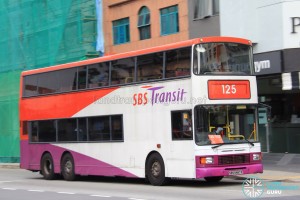
Later Modifications:
All buses of this batch were modified with a standee area which was made possible by removing four sets of double-seats. The modified seating configuration carries 139 passengers, comprising 55 upper deck seating, 29 lower deck seating, and 55 standing passengers.
All buses of this batch (except SBS9496U) were refurbished with red leather air-con ducts and newer ball-type aircon vents, and hence received a lifespan extension of two years. They were fully retired by 2016.
SBS9401T has a wooden plaque commemorating the launch of the Superbus by then-Rear Admiral Teo Chee Hean, mounted above the fare validator near the bus entrance.
Differences between Batch 1 and 2 Volvo Olympians are listed in the table below:
| Volvo Olympian | |
| Batch 1 | Batch 2 & 3 |
| – Circular headlights – Rear window on upper deck – Blue interior lighting – Polished metal handlebars – Curved bar above seat |
– Square headlights – No rear window on upper deck – Yellow interior lighting – Yellow textured handlebars (for more grip) – Rectangular bar above seat |
Batch 3 (SBS9601H – SBS9670H)
In 1998, Singapore Bus Services (SBS) placed a final order of 70 more Volvo Olympians with the Royale bodywork produced by Walter Alexander. This third batch of Volvo Olympians were registered between 5 Mar 1999 – 26 Dec 2000. Registration numbers from SBS9601H – SBS9670H were used.
The third and final batch of Volvo Olympians were a smaller batch of just 70, as opposed to 200 and 201 for the first two batches. These buses were delivered very late, and the last units were delivered in December 2000 (as compared to the first few delivered in June 1994). These buses are believed to be surplus chassis prior to the closure of the Volvo Olympian production line, with SBS9669M being the last SBS Transit Volvo Olympian chassis to be manufactured (as per chassis number order).
The Batch 3 were delivered with the standee area, unlike the Batch 1 and 2 buses which had to be modified through the removal of seats. It carries 139 passengers, comprising 55 upper deck seating, 29 lower deck seating, and 55 standing passengers
Later Modifications:
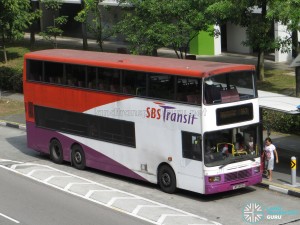
All buses of this batch were refurbished with red leather air-con ducts and newer ball-type aircon vents, and hence received a lifespan extension of two years. Unlike the Batch 2s, Batch 3 Volvo Olympians come with rim caps, although some buses had them removed.
In 2011, SBS Transit installed Electronic Display Signages (EDS) units supplied by LECIP on all Batch 3 Volvo Olympians, making them easily distinguishable from their Batch 2 counterparts. These electronic signs were installed on the front, side and upper deck rear.
These buses also received an upgraded fare collection system, comprising the Integrated Driver’s Fare Console (IDFC) and four large-screen turquoise-colored card readers. Towards the end of their lifespan, some buses were also installed with the Trapeze Common Fleet Management System (CFMS).
| SBS Transit Volvo Olympian | ||||
| 2-axle (10.5 m) | 3-axle (Batch 1) | 3-axle (Batch 2) | 3-axle (Batch 3) | |
| Registration | SBS7198T – SBS7297R | SBS9200G – SBS9400X | SBS9401T – SBS9600K | SBS9601H – SBS9670H |
| Quantity | 100 | 201 | 200 | 70 |
| Registration Period | 14 Jun 1994 – 24 Feb 1995 | 10 Jun 1994 – 28 Jun 1995 | 17 Aug 1996 – 10 Feb 1998 | 5 Mar 1999 – 26 Dec 2000 |
| Technical Specifications | ||||
| Engine | Volvo TD102KF, 9603 cc Power/Torque rating of 245 hp (180 kW) @ 2200 rpm / 1050 Nm @ 1250 rpm |
|||
| Transmission | Voith DIWA 851.2 | ZF Ecomat 4HP 500 | ||
| Passenger Capacity*. | U43 + L22 + S29 = 94 | U55+ L30 + S54 = 139 | U55+ L29 + S55 = 139 | U55+ L29 + S55 = 139 |
| Additional Specifications | — | — | — | — |
* – Passenger capacity: U = Upper Deck, L = Lower Deck, S = Standing. Modified seating capacities shown.
Interior: (Batch 3)
Lower Deck
The lower deck of the Batch 3 Volvo Olympian features 29 seats. The bus has two doors: an entrance door at the front, and an exit door in the middle. Both doors are inward-swinging double-leaf doors supplied by Deans and are pneumatically operated.
The front section of the bus has three side-facing seats above the wheel well. On the right and underneath the staircase is a ticket validator, which is used only as a ticket printer since magnetic farecards have since been phased out. Upper deck seat counters are developed in-house by SBS and fitted to the Volvo Olympian as standard.
The rear section of the upper deck features a standee area with bifurcated stanchion poles and grab poles near the window. While standard to the Batch 3 as shown here, earlier batches of Volvo Olympian buses were modified to include a standing area by the removing of 8 seats. Just behind the exit door, three rows of front-facing seats are designated priority seats and are indicated using green seat covers.
Towards the rear of the bus are more side-facing seats. The last row of the bus has five forward-facing seats.
Upper Deck
The upper deck of the Volvo Olympian seats 55 in a conventional four-abreast seating, with the rearmost row seating five.
Staircase
A single staircase connects both upper and lower decks of the bus.
Gallery:
External Links & References:
Back to Bus Models
Back to Bus Articles
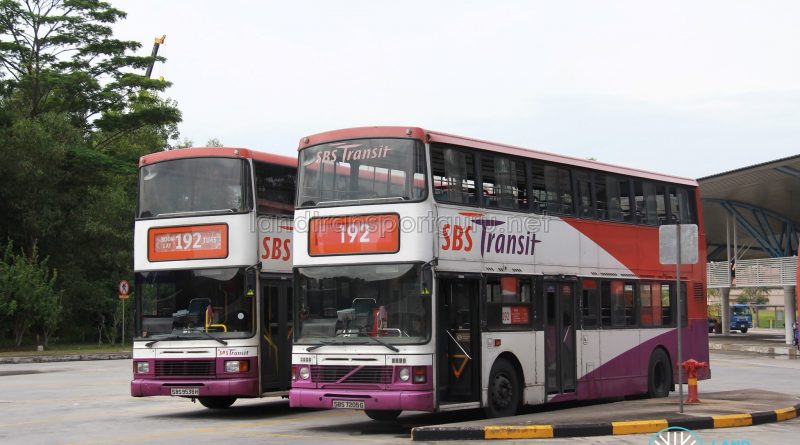
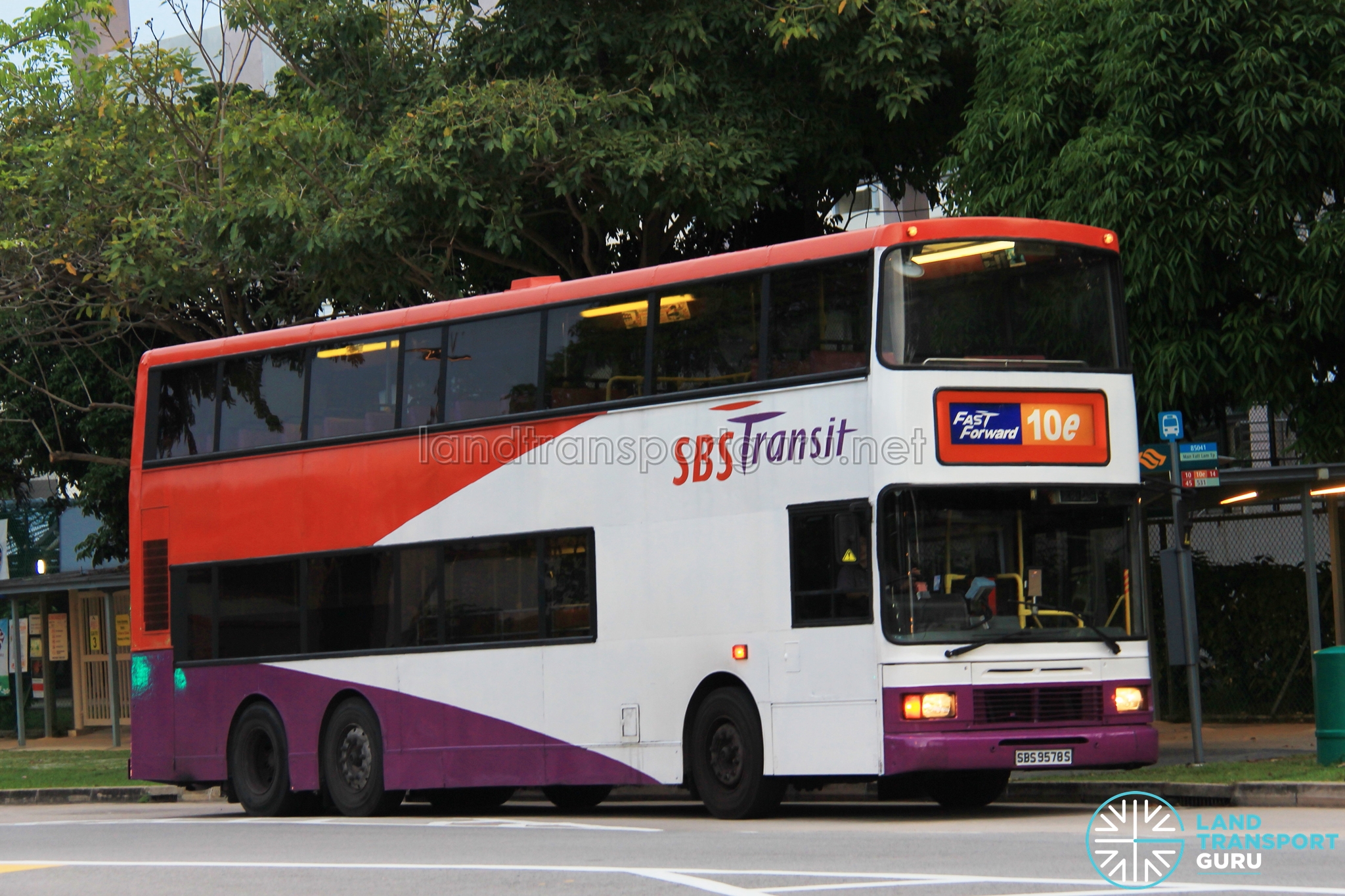
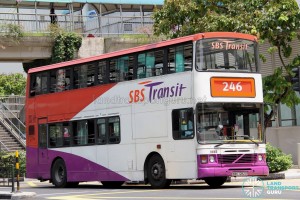
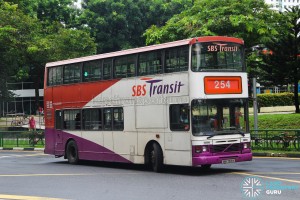

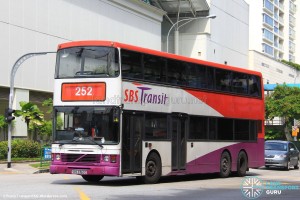


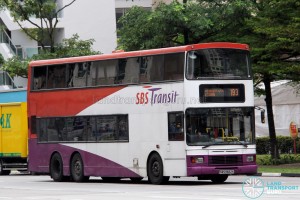

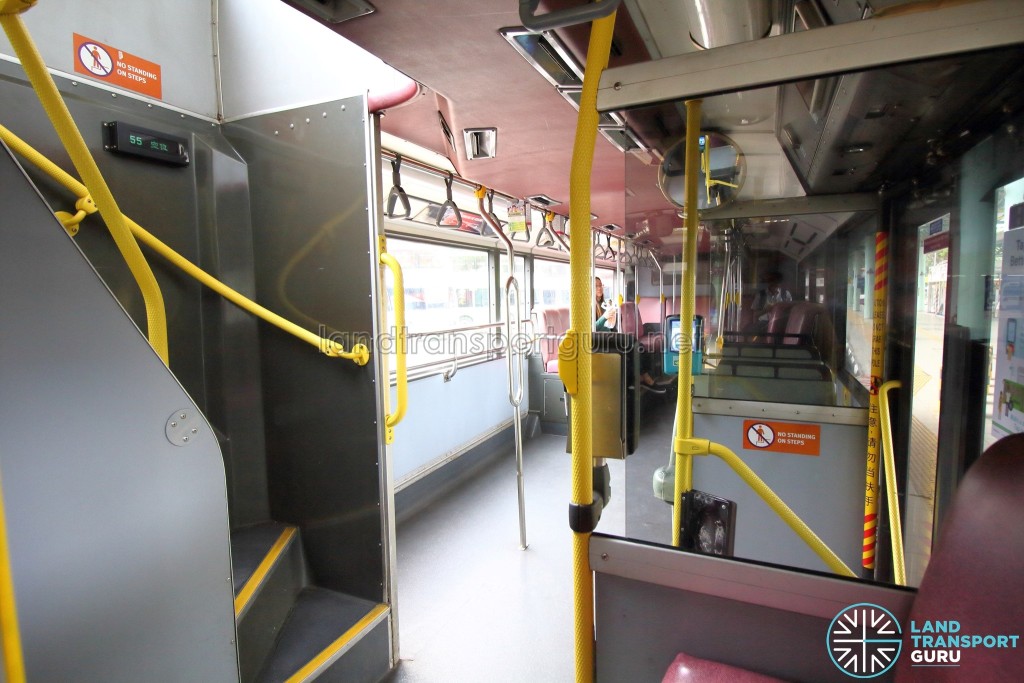
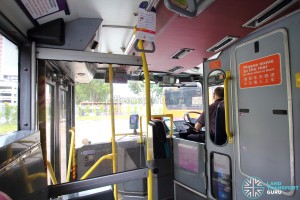
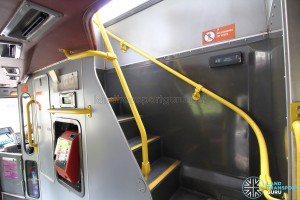

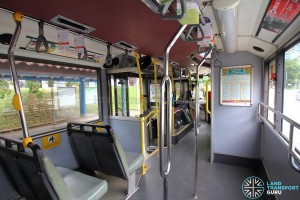

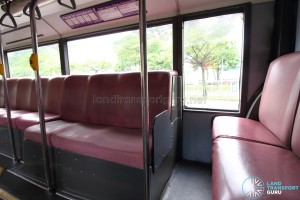
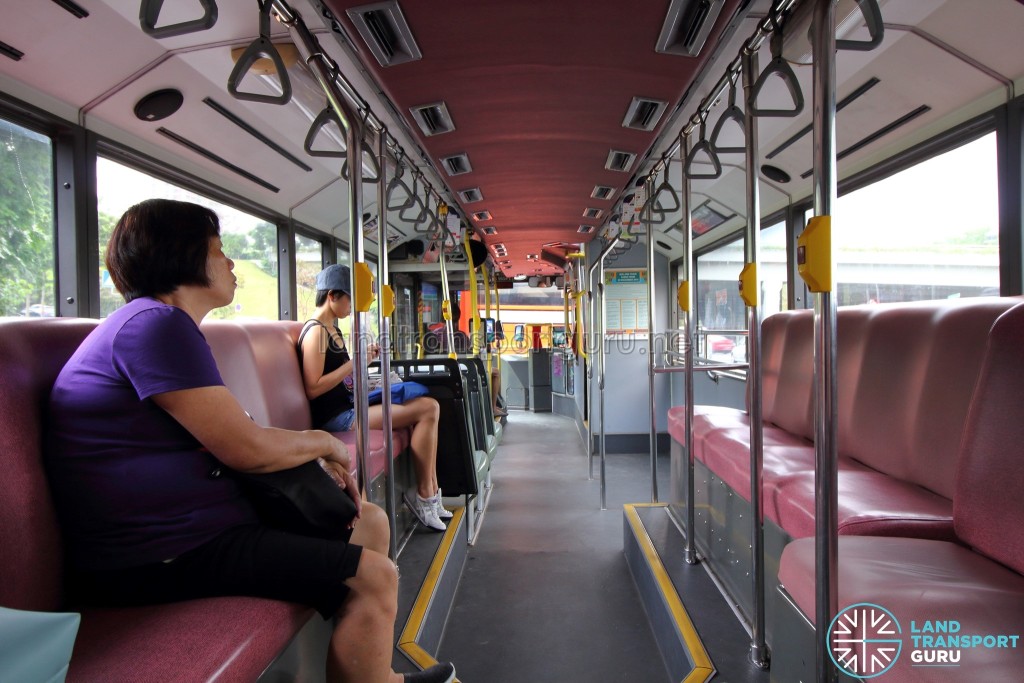

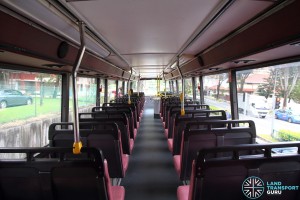

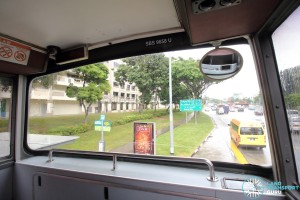
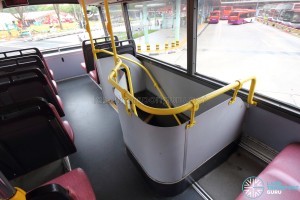

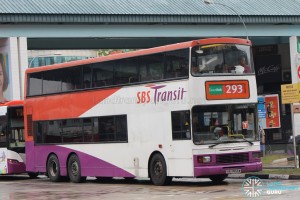

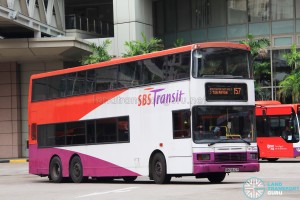




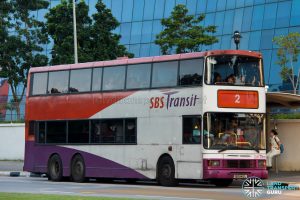
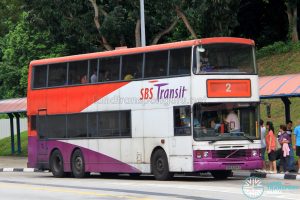
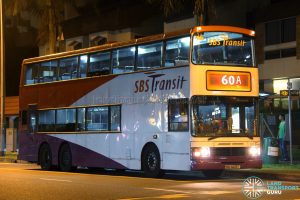

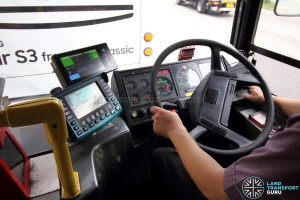
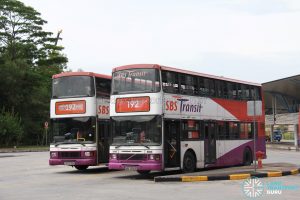
Since Volvo Olympian Batch 3 buses have speakers, and some of them were installed with the Trapeze CFMS, they should have configured these speakers to play Next Stop announcements from the CFMS in Olympian buses.
SBS7227T has since been gone from Temasek Junior College as of November 2018.
Now it has been scrapped, no longer a static vehicle in Temasek Junior College.